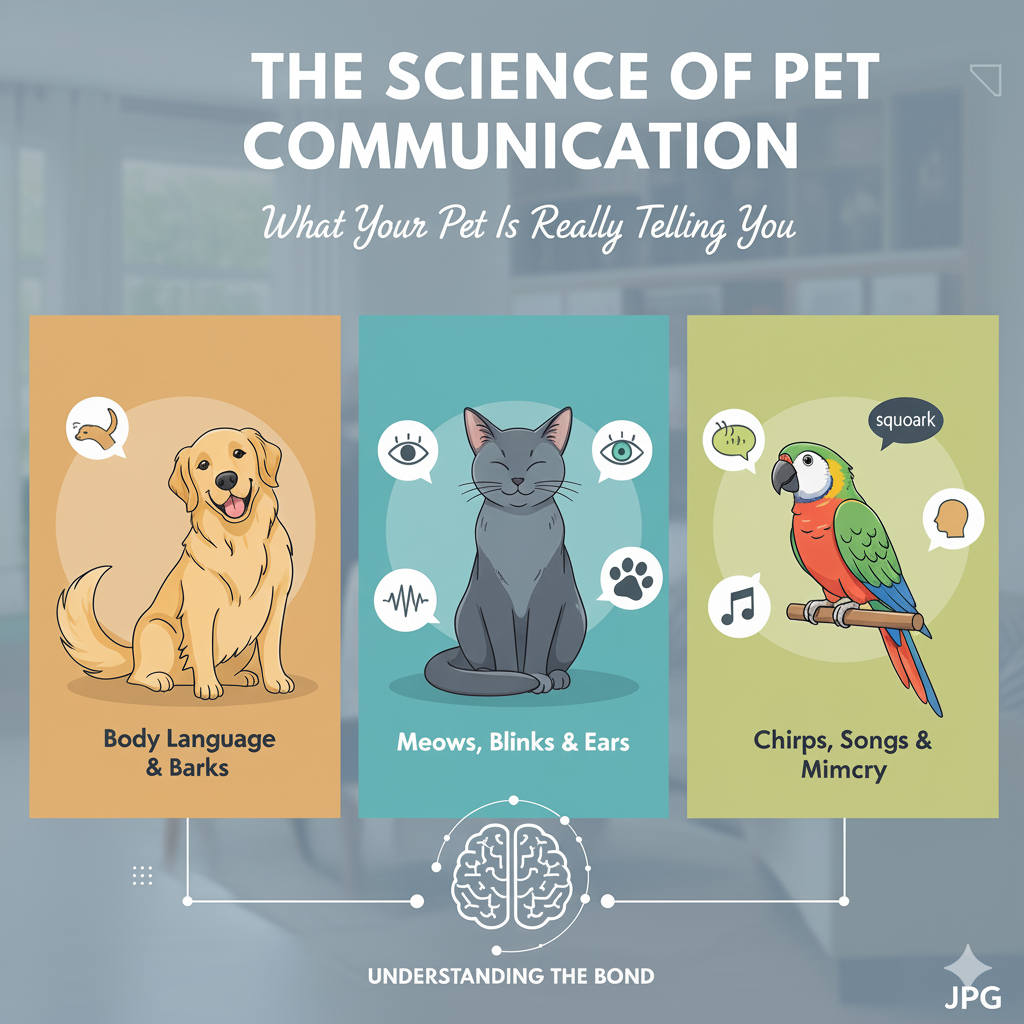The Science of Pet Communication: What Your Pet Is Really Telling You
The Science of Pet Communication: What Your Pet Is Really Telling You
Discover the fascinating world of animal communication and learn to decode your furry friend’s secret language
Have you ever wondered what your dog’s tail wag really means, or why your cat purrs at specific moments? Pet communication is a complex and fascinating field that combines animal behavior science, psychology, and years of careful observation. Understanding how our beloved companions communicate can transform your relationship and help you provide better care for your furry family members.
Modern research in animal communication reveals that pets use sophisticated methods to express their needs, emotions, and thoughts. From subtle body language cues to vocal patterns, our pets are constantly sharing information with us – we just need to learn their language.
🔬 The Scientific Foundation
Recent studies in animal cognition show that pets possess remarkable communication abilities. Research from leading universities demonstrates that dogs can understand over 150 words, while cats use more than 16 different vocalizations to communicate with humans specifically.
Understanding the Basics of Pet Communication
Pet communication operates on multiple levels simultaneously. Unlike human communication, which relies heavily on verbal language, animals use a combination of body language, vocalizations, scent marking, and behavioral patterns to convey their messages.
The foundation of effective pet communication lies in understanding that animals are always communicating – even when they appear to be doing nothing. A relaxed posture, steady breathing, and calm eyes all convey important information about your pet’s emotional state.
👁Visual Communication
Body language, facial expressions, and posture make up the largest portion of animal communication. Dogs use their entire body to communicate, from ear position to tail movement, while cats rely heavily on eye contact and whisker positioning.
🔊Vocal Communication
Beyond basic barks and meows, pets develop sophisticated vocal patterns. Research shows that cats modify their vocalizations specifically for human ears, while dogs adjust their bark frequency based on the situation and intended recipient.
👃Scent Communication
Often overlooked by humans, scent plays a crucial role in pet communication. Animals leave chemical messages through scent marking, providing information about identity, health, emotional state, and territorial boundaries.
⚡Behavioral Communication
Repetitive behaviors, play patterns, and daily routines all serve as communication tools. Your pet’s behavior patterns often reflect their attempts to communicate specific needs or emotional states.
Species-Specific Communication Patterns
Each species has evolved unique communication methods adapted to their natural behaviors and social structures. Understanding these species-specific patterns is crucial for effective pet communication.
🐕 Canine Communication
Dogs are naturally pack animals with complex social hierarchies. Their communication includes subtle dominance and submission signals, play invitations, and stress indicators. The famous tail wag has numerous variations – a high, fast wag indicates excitement, while a low, slow wag might signal uncertainty or submission.
🐱 Feline Communication
Cats developed most of their vocalizations specifically for communicating with humans. Adult cats rarely meow at other cats, instead using this behavior almost exclusively for human interaction. Purring, contrary to popular belief, isn’t always a sign of happiness – cats also purr when stressed, injured, or seeking comfort.
🐰 Small Mammal Communication
Rabbits, guinea pigs, and other small pets use subtle body language and soft vocalizations. Rabbits thump their hind legs to signal danger, while guinea pigs use a variety of squeaks and purrs to express emotions ranging from excitement to distress.
🐦 Avian Communication
Birds are among the most vocal pets, using complex vocalizations, body posturing, and feather positioning to communicate. Many bird species can learn human words but also develop their own “contact calls” specifically for their human family members.
Decoding Common Pet Behaviors
Learning to interpret your pet’s behavior is like learning a new language. Each gesture, vocalization, and action carries meaning. Here’s what science tells us about some of the most common pet communication behaviors:
🎯 Key Behavioral Indicators
Research shows that 93% of communication between pets and humans is non-verbal. This means that understanding body language and behavioral cues is far more important than focusing solely on vocalizations.
Stress Signals: Many pets communicate stress through subtle changes in behavior. Dogs might pant excessively when not hot, pace, or show changes in appetite. Cats may hide, over-groom, or change their bathroom habits. These behaviors are your pet’s way of saying they need help managing their stress levels.
Attention-Seeking Behaviors: When pets repeatedly perform certain actions, they’re often trying to communicate a specific need. A dog that brings you their leash is clearly communicating their desire for a walk, while a cat that sits on your keyboard is likely seeking attention and interaction.
Comfort and Bonding Signals: Pets show affection and comfort through various behaviors. Dogs might lean against you, bring you toys, or make eye contact with soft, relaxed expressions. Cats show affection through head butting, kneading, and slow blinks – often called “cat kisses.”
The Science Behind Pet Communication
Modern neuroscience and animal behavior research have revealed fascinating insights into how pet communication works at a biological level. These discoveries help us understand not just what our pets are communicating, but how and why they communicate.
🧠 Neurological Basis
Brain imaging studies show that dogs process human speech in similar ways to humans, using the left hemisphere for words and the right for emotional tone. This explains why dogs respond not just to what we say, but how we say it.
🔬 Chemical Communication
Pets release pheromones and other chemical signals that convey emotional states. Dogs can detect these chemicals from other dogs and humans, while cats use facial pheromones to mark territory and show comfort.
📊 Learning and Adaptation
Research demonstrates that pets actively learn and adapt their communication strategies based on human responses. They modify their approach based on what works most effectively with their specific human companions.
⏰ Circadian Influences
Pet communication patterns change throughout the day, influenced by natural circadian rhythms. Understanding these patterns helps pet owners recognize when their pets are trying to communicate specific needs.
Practical Tips for Better Pet Communication
Improving your pet communication skills takes practice, patience, and observation. Here are evidence-based strategies that veterinarians and animal behaviorists recommend:
👀 Observation Techniques
Spend dedicated time each day simply observing your pet without distractions. Notice their body language, breathing patterns, and subtle behavioral changes. Keep a communication journal to track patterns and triggers.
🗣️ Consistent Communication
Use consistent words, tone, and body language when communicating with your pet. This helps them learn to associate specific signals with particular meanings, improving overall pet communication effectiveness.
⏱️ Timing Matters
Pay attention to when your pet is most communicative and receptive. Many pets have specific times of day when they’re more likely to engage in social communication behaviors.
🎭 Mirror Behavior
Subtly mirroring your pet’s calm energy can improve communication. If your pet is relaxed, matching their energy level often makes them more receptive to interaction and training.
🏆 Positive Reinforcement
When your pet successfully communicates a need and you respond appropriately, reinforce this behavior with praise, treats, or attention. This encourages continued communication efforts.
🚫 Avoid Punishment
Never punish your pet for attempting to communicate, even if their method isn’t ideal. Instead, redirect unwanted communication behaviors toward more appropriate alternatives.
Common Communication Mistakes Pet Owners Make
Even well-intentioned pet owners sometimes misinterpret their pet’s communication attempts. Understanding these common mistakes can significantly improve your pet communication skills:
Anthropomorphizing: While pets do experience emotions, projecting human motivations onto animal behaviors can lead to misunderstandings. For example, a dog that chews furniture isn’t “getting revenge” – they’re likely expressing anxiety, boredom, or a need for mental stimulation.
Ignoring Context: Pet behavior always occurs within a context. A cat hiding under the bed might be sick, stressed, or simply seeking a cool, quiet place to rest. Consider environmental factors, recent changes, and your pet’s overall health when interpreting their communication.
Inconsistent Responses: When pet owners respond differently to the same communication attempt, it confuses pets and can lead to escalated behaviors. Consistency in your responses helps your pet understand what works and what doesn’t.
⚠️ Warning Signs to Watch For
Sudden changes in communication patterns often indicate health issues or significant stress. If your normally vocal pet becomes silent, or your quiet pet suddenly becomes very vocal, consult with a veterinarian to rule out medical causes.
The Role of Environment in Pet Communication
Your pet’s environment significantly influences their communication patterns and effectiveness. Pet communication doesn’t occur in a vacuum – it’s shaped by surroundings, routine, and environmental stressors.
Safe Spaces: Pets communicate more freely when they feel secure. Creating designated safe spaces in your home where your pet can retreat and relax encourages open communication and reduces stress-related behavioral issues.
Noise Levels: Excessive noise can interfere with your pet’s ability to communicate effectively. Dogs rely heavily on hearing for communication, while cats use subtle vocalizations that can be masked by household noise.
Social Dynamics: In multi-pet households, communication becomes more complex. Pets must navigate not only human-animal communication but also inter-pet relationships, which can affect how they communicate with family members.
Building Stronger Bonds Through Communication
Effective pet communication is the foundation of a strong human-animal bond. When pets feel understood and their communication attempts are acknowledged, they become more confident, less anxious, and more cooperative.
Research shows that pets who have strong communication relationships with their owners exhibit fewer behavioral problems, adapt more quickly to new situations, and show greater resilience during stressful events. This improved relationship benefits both pet and owner, creating a more harmonious household.
Trust Building: Consistent, respectful communication builds trust over time. When you reliably respond to your pet’s communication attempts, they learn that their messages are valued and heard, encouraging continued communication.
Mutual Understanding: As you become more skilled at interpreting your pet’s communication, they simultaneously become better at understanding your signals. This creates a positive feedback loop that strengthens your relationship.
Start Your Pet Communication Journey Today
Understanding your pet’s communication is an ongoing journey that deepens your relationship and improves their quality of life. Begin by spending a few minutes each day observing and responding to your pet’s communication attempts.
Conclusion: The Future of Pet Communication
The science of pet communication continues to evolve as researchers develop new methods for studying animal cognition and behavior. Emerging technologies, including AI-powered behavior analysis and advanced biometric monitoring, are providing unprecedented insights into how our pets think and communicate.
As our understanding of animal communication grows, so does our ability to provide better care, reduce stress, and strengthen the bonds we share with our companions. By applying the principles and techniques discussed in this article, you’re taking important steps toward becoming a more effective communicator with your beloved pet.
Remember that every pet is an individual with their own unique communication style. What works for one animal may not work for another, even within the same species. Patience, observation, and consistent practice are the keys to mastering the art and science of pet communication.


